“Colorblind” discipline still divides races
April 18, 2018
According to the U.S Department of Education, the U.S. spent $69.4 billion in discretionary funding on the Department of Education in 2017, an increase of almost $1.3 billion since previous years. In 2010 alone, the U.S. spent 39 percent more per full-time student for elementary and secondary education than any other country.
Yet, despite the increase in money spent, educational outcomes continue to dwindle. In fact, American education remains rife with problems, starting with the gaping differences in the treatment and racial inequality between white students and students of color.
Stanford Cepa, a center for educational policy, reports that racial, ethnic, and socioeconomic disparities
in academic achievement remain a stubborn feature of U.S. schooling. National studies performed by Cepa also consistently show that the average non-Hispanic black student scores well below the average non-Hispanic white student on standardized tests of math and reading skills, along with the average Hispanic student.
“We had an administrative meeting, and while a guest speaker exposed us to the actual number documentation of the socioeconomic role that does come into play before students even hit the door to North Cobb High School, it then effects how they and if they choose to act on the vast opportunities we offer at the school,” Principal Bucky Horton said.
Likewise, the average student from a low-income family scores much lower on such tests than students from higher-income families. “Considerable attention has been focused on achievement gaps, particularly the black-white achievement gap,” Stanford Cepa reported.
“Racial inequality still does exist. Currently there are more minority teachers centered more towards the county. They may say it’s because it’s due to the student population, but I still think that students benefit from a wider variety of teachers as of now I am still the only minority science teacher in the department and it’s been that way for some time, ” NC Physics teacher Elizabeth Walker said.
More than 60 years after Brown vs. Board of Education, students still feel school systems in the United States are separate and unequal due to the socioeconomic status people of color tend to uphold.
“As a child my parents taught me about the systematic oppression against students of color and how I will oftentimes will be the only one in the room. I am now 17 and I still have to remind myself of this. It hurts me to see that there are other POCs who did not have the support or even the equal option to challenge themselves through education because of a system that diminishes their potential,” junior and Black Student Union member Aysia Hilliard said.
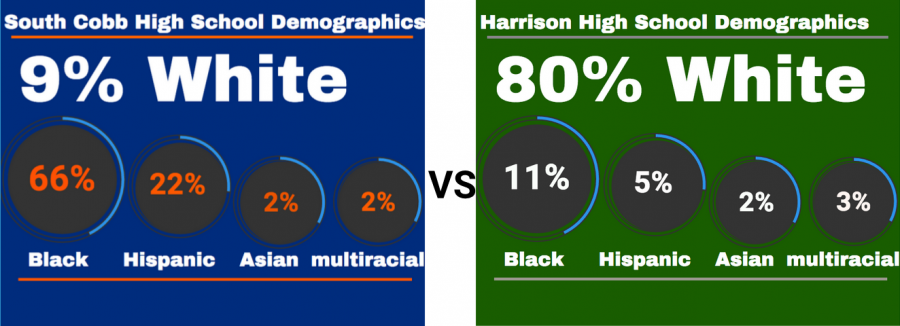 Chloe Roberson
Chloe Roberson
By 2022, the number of Hispanic students in public elementary and secondary schools remains projected to grow 33 percent from the 2011 numbers. While, the number of multiracial students remains expected to grow 44 percent. However, the experiences with racial inequality will drastically increase as the projected growth of students of color entering the school system continues to rise.
“Systemic racism within the school system absolutely exists it’s gotten to the place where its unconsciously done, I don’t think it’s necessarily intention rather than a person acting without thinking about what their doing and when you call them on it they get offended and the funny part is people are more offended when you call them a racists rather than they are being racists,” Walker said.
At NC alone, more than 25 out of 50 students of color reported feelings of inequality through unequal school discipline, treatment, and distribution of respect. These feelings run rampant through halls and frequent incidents displaying this unequal treatment of students of color compared to white students becomes more and more prevalent from the students’ point of view.
“I was just walking through the hall during the pledge to get to homeroom when I was stopped by a teacher, I was told the reason I was asked to stop was for the pledge and ‘have some respect.’ I told her I do not acknowledge the pledge so I shouldn’t have to stop in the middle of the hallway because even other students are still walking around us. I was then written up and it said: Diana was asked to stop in the hallway during the pledge of allegiance and moment of silence. She refused. This created a disruption to other students,” senior Diana Martinez said.
Following this incident, Martinez received three days of in school suspension.
“I just don’t feel that was equal treatment because if you do it to one student you must do it to others or else it’s not equal or fair,” Martinez said.
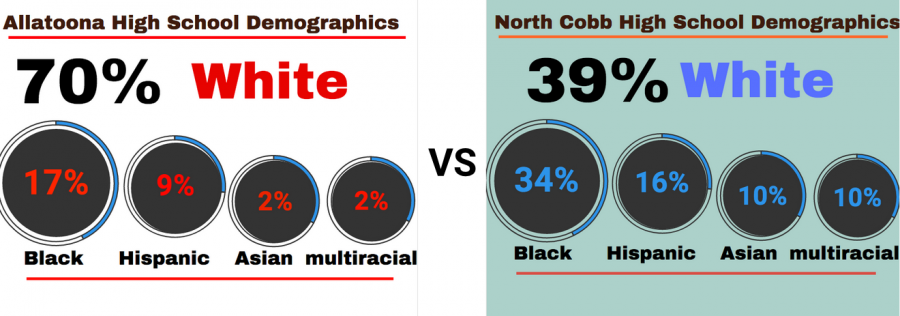 Chloe Roberson
Chloe Roberson
Staff members of color note the treatment of minorities within the school as a growing issue.
“I do think these students of color are singled out in a way, and are noticed a little bit more. However, a lot of other races do carry the same offenses. Black, white, hispanic and so on, but a lot of the times the black or the brown students are looked at more closely. Even the rules or regulations that they decide to enforce are ones that adversely impact black or brown students,” Math teacher Brenda Slater said.
Administrators at schools such as NC emphasize that they always try to keep discipline as fair as possible, however the codes and behavioral matrix designed at the district and state level clearly depict a degree of institutionalized racism.
For example, according to the Cobb County Code of Conduct, “policies/Rules of the Cobb County Board of Education require full compliance with all federal and state non-discrimination laws, including: Title VI and VII of the Civil Rights Act of 1964, along with Title IX of the Educational Amendments of 1972.” This means in order for policies and rules to maintain validity they must not display as defined by the Title VI law, any discrimination on the basis of race or color.
In reality, to a degree a fraction of these policies give unequal treatment towards races who are more susceptible to breaking these rules or policies due to a society and country built and formulated to keep people of color at a lower level of economic and educational success.
In Atlanta, during the year of 2012-2013 African-Americans were 54 percent of the population, but responsible for 100 percent of homicide, 95 percent of rape, 94 percent of robbery, 84 percent of aggravated assault, and 93 percent of burglary according to a Uniform Crime Report.
Moreover, drug policies especially create open traps for drug users who are primarily students of color. The reasoning behind this drug use goes back to documented economic strife and effect of unequally awarded opportunities between non-people of color and people of color. Nevertheless, there remains a clear disproportionate minority contact in the Cobb County juvenile justice system alone.
To explain, a Georgia Crime Information Center 2016 summary report, states that of the 2,038 Cobb County juvenile arrestee populace, more than 50 percent identified as a person of color.
“I know that disciplines are designed to be fair. The code of conduct should apply to every administrator in schools within Cobb County and should apply to every student situation regardless of that students color or background, but any student no matter their background should have the opportunity to have their behavioral situation looked at assertively and equitably,” NC Assistant Principal/International Studies Program Coordinator David Stephenson said.
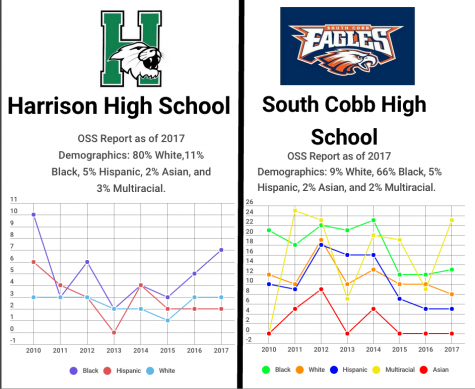 Chloe Roberson
Chloe Roberson
In addition, this form of unequal treatment and opportunities does not only occur at the high school level, early events occur that can stall a students development and success.
“When I was tested to be in target during elementary school, me and another POC were not seen as ‘fit’ for the program. Once I gave my parents that official letter sent by the school, they were furious. I didn’t understand at first but once they explained how many African-American children are overlooked solely because of their skin color, it was clear that me and my friend were a victim of this. Once we were tested our scores guided us through a pathway to higher education and success,” NC Black Student Union Member Ayia Hilliard said.
However, a crucial step towards equality from a student’s point of view lies with an increase in diversity and changes in school policy at the district or state level, and making an attempt to relate to students of color on a deeper and cultural level. These actions to students can potentially remedy or salvage the children already trekking down the dark path filled with the roots of missed opportunities and unequal treatment.
For example, according to a revised 2018 Cobb County Enrollment report conducted by the Georgia Department of Education, nearly 70,000 out of 112,084 students are persons of color.
This remains a large increase from the figures presented eight years ago. In 2010, a mere 41,318 out of 106,630 students identified as a person of color. This includes Asians, Pacific Islanders, American Indians, Blacks, and Hispanics.
With the largest contribution in Cobb County School District coming from the black community, it remains fair to conclude that the highest potential for economic stimulation and growth comes primarily from the success and access to educational opportunities this group obtains.
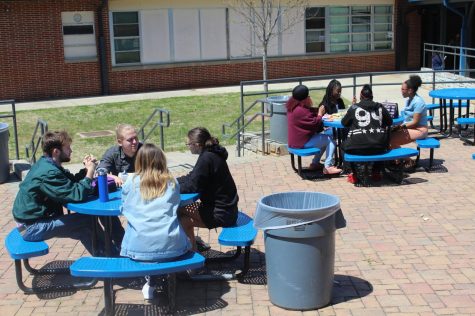
During lunch, NC students tend to associate with students who resemble themselves. The female students’ lunch table located to the upper far right contains only student of color. In the same nature, male and females congregate together at the lunch at the table to the left, however, they resemble each other’s racial background.
“There is a systematic oppression that wants to hold down the endless possibilities of what People of Color can do. With that being said, access to good education is much harder for people who live in projects and ghettos across the nation. And many people believe that living in these circumstances can be undone by “self-help” but there is a cycle that keeps the youth from growing into adults with careers rather than jobs. My mother works at the lowest performing high school in Georgia for a new program called JA Academy. The goal is to liberate the students from the future that many believe is inevitable, like: working a 9-5, going to jail, or ending up dead by 18. The things I have access to at North Cobb are not even heard of down in the Metro Atlanta area,” Hilliard added.
Another full time student offers her perspective and course of action for tackling this delicate issue.
“Increasing diversity through schools is one of the smartest actions counties can take. When I sit in a classroom filled with people just like me I can feel and see that nothing’s going to change, everything is the same, and I have no motivation to improve anything because of how uninterested I am in other people who are my race. I’m not saying that white people are boring, and every one of us are the same, but when I see a class filled with color and different ethnicities, I get excited because I know I’m going to be learning about something different and interesting. Hearing people talk about things you’ve never experienced or seen is engaging. I like to know more about someone’s culture and how it’s different from mine,” senior Hope Hutchins said.
Lacking diversity can lead to discouragement and loss of motivation in students of color which plays a key role in the unequal career opportunities that arise from multitude of better treatment afforded to non-POC students.
“If a child says, hey I don’t really see educational success in my homes, I’m not seeing myself represented in school, television or people of their race represented positively in social media, whatever the case may be— If they do see it at school they only see it in 1 out of 157 teachers,” Social Studies teacher Matthew Sanders said.
For example, a Georgia School Discipline report, revealed that African Americans were disproportionately disciplined in Georgia schools and other schools in the south. They also found that a fair amount of these students fall behind academically due to suspension or other forms of discipline that takes students away from their studies. Subsequently, when these students cannot catch up, they resort to misbehaviors out of frustration and anger.
“I’ve been suspended. I don’t know how many times. It’s almost a cycle at this point, and my parents have given up on me, and so have I. I’ve been out for so long that I get so frustrated when I don’t get something that we learned when I was out that I will literally just put my head down,” senior and frequent suspendee Amiri Europe said.
On the other hand, “though in certain circumstances necessary and warranted expulsion and other harsh disciplinary measures still take students completely out of educational settings and greatly impedes prospects for future success,” a GA School Discipline report said.
“We recognize that it is the student’s responsibility to maintain their own course work during times of suspension. They are given support from teachers,” Principal Bucky Horton said.
While the cost to keep other students safe impedes the prosperity of students of color, still the fact remains that Black students are expelled at three times the rate of white students according to a 2017 Brown Center report on American Education.
“I think that discipline is such a tough thing, but I think when discipling a child we need to look at that particular kid of that background. There should be some objectivity and subjectivity there. I guess I’m talking out of both sides of my neck because sometimes you do have to be subjective, but you also have to be objective. Like, what is the best thing for that kid? Is the best thing for that kid to have three days of OSS being able to make up his work. OK fine. Is the best thing for that kid to go find another course of his career, whether it’s going out and receiving a vocational diploma or other opportunities of that nature. We need to take into consideration what is the best thing for that particular kid in their present situation in life,” Social Studies teacher Matthew Sanders said.
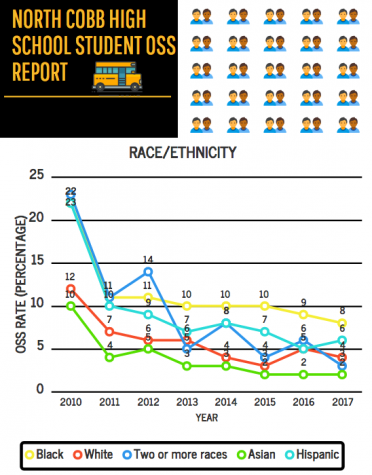 Chloe Roberson
Chloe Roberson
According to The Georgia Appleseed, a center for law and justice, at NC, black students maintain the highest OSS rate than any other race, followed by Hispanic students and students who contain two or more races.
“The stance of North Cobb is basically we don’t take race into account. When we administer discipline we have a matrix that we follow. We take the name and we look at if this is the child’s first offense; however blacks having the highest OSS rate does say something about the system’s makeup,” NC Assistant Principal Kiel Southwell said.
NC teachers react to the OSS rates and question the real reason behind the behavioral infractions themselves.
“The statistic is not surprising or shocking. Is there something that can be done about these rates? Possibly yes, but like I said, what at home is happening in these students of color’s lives preparing them for what they recieve here? Why aren’t they making the best decisions at North Cobb for themselves and trying to have the lowest OSS rate at North Cobb. It’s partly high rate is societal, partly educational, particularly in my role as a black male teacher is significant because they don’t see anybody that looks like them in the building,” Sanders said.

Michael Roberson • Apr 19, 2018 at 2:11 PM
Great journalistic expose of the state and condition of persons of color. I suggest that we research different approaches to deal with the problem of school suspension. Total removal of students from academic settings is creating develmental lags.